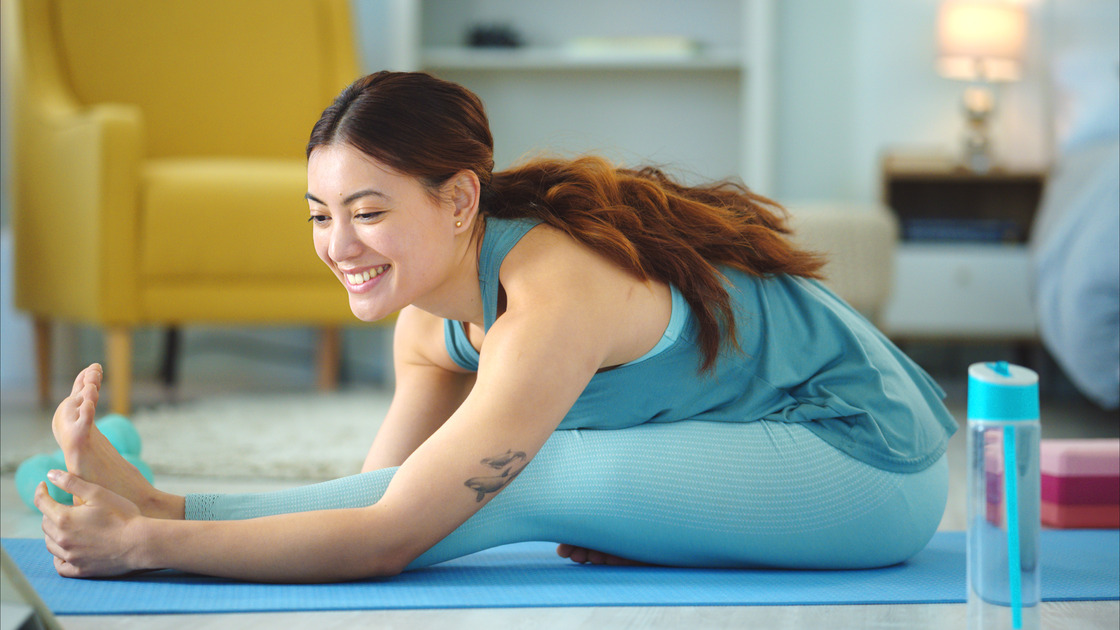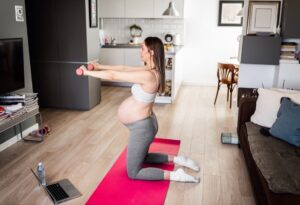Recent research published in the Scandinavian Journal of Medicine and Science in Sports suggests a strong correlation between physical flexibility and a reduced risk of mortality in middle-aged individuals. While not a direct cause, flexibility serves as a key physiological indicator of overall health, signaling a body with less inflammation and better function. A consistent ten-minute daily routine can significantly enhance your range of motion, improve circulation, and reduce stiffness, which helps prevent age-related injuries and falls. This simple, sustainable practice is a powerful form of preventive care that supports a longer, more active life.
Part I: The Scientific Foundation of Flexibility and Longevity
1.1 The Primary Link: Flexibility as a Marker of Longevity
The concept that physical flexibility could be a predictor of a longer, healthier life has been supported by recent, compelling research. A landmark 2024 study published in the Scandinavian Journal of Medicine and Science in Sports provides the most robust evidence to date. This prospective cohort study involved over 3,000 middle-aged men and women between the ages of 46 and 65. Investigators measured participants’ overall body flexibility using a comprehensive “Flexindex” score, which assessed the passive range of motion across 20 movements involving seven different joints. The study then tracked the mortality rates of these individuals over an average follow-up period of 12.9 years. Want To Live Longer? Science Says To Stretch
The results demonstrated a significant inverse relationship: individuals who scored higher on the flexibility test had a substantially lower risk of death from natural causes. The data was particularly striking when comparing the mortality risks between high and low flexibility groups. Men with a low Flexindex had a 1.87-times higher risk of dying, while women with a low Flexindex faced a remarkable 4.78-times higher risk of death compared to their highly flexible counterparts. The research strongly suggests a correlation between maintaining and improving flexibility and enhancing long-term health, placing it in the same category of importance as aerobic fitness for survival.
1.2 Deconstructing Correlation vs. Causation
While the findings of the 2024 study are compelling, it is crucial to understand the distinction between correlation and causation. The research does not definitively establish that stretching directly extends lifespan. Rather, it indicates a strong relationship between the two. The logical interpretation is that flexibility serves as a physiological biomarker—an observable indicator of an individual’s overall health status. A body that is supple and mobile is often a body that is functioning well at a deeper level. How Your Flexibility Impacts Your Longevity
Limited mobility and inflexibility may signal the presence of a variety of underlying health issues. For example, joint stiffness and muscle imbalances can be indicators of chronic inflammation, poor posture, or degenerative conditions like arthritis. These conditions can contribute to a decline in physical function and increase the risk of injury over time. By maintaining flexibility, an individual may be signaling that their body is successfully managing these systemic challenges. Therefore, the practices that lead to flexibility—such as daily stretching—are not just beneficial in themselves, but are also part of a broader lifestyle that supports vitality, resilience, and, ultimately, longevity.
Part II: A Comprehensive Analysis of Stretching’s Health Benefits
2.1 Musculoskeletal Health, Mobility, and Injury Prevention
The most recognized benefits of stretching are rooted in its direct impact on the musculoskeletal system. A consistent stretching routine helps to preserve and augment flexibility and range of motion, which are essential for navigating daily life as the body ages. Over time, joints can naturally lose flexibility, making simple tasks like getting out of bed or reaching for objects more challenging. By actively working to maintain pliable muscles, individuals can ensure they stay mobile and independent as they age. Benefits of Stretching as You Age
The enhancement of flexibility also has a profound effect on injury and fall prevention. Flexible muscles are inherently more resilient, which significantly reduces the likelihood of strains and sprains. For older adults, this benefit is particularly critical. Falls are a major health concern, with more than 3 million emergency room visits each year attributed to them. Research indicates that regular stretching can improve balance and walking ability, and a lack of lower-extremity flexibility is a known risk factor for falls. By improving core components like strength, balance, and flexibility, individuals can significantly reduce their fall risk and enhance their confidence in movement. The ability to perform everyday actions without pain or limitation is a direct result of these practices, which contribute significantly to a prolonged period of autonomous living and a higher quality of life.
2.2 Systemic and Cardiovascular Wellness
The positive effects of stretching extend far beyond the musculoskeletal system, influencing core physiological processes that are central to long-term health. The practice of stretching improves blood circulation, which in turn enhances the delivery of oxygen and nutrients to muscles and joints. This increased blood flow can also help to keep arteries more flexible and elastic, thereby preventing high blood pressure, a leading cause of heart disease and stroke. One study found that a 12-week stretching program had a positive effect on artery flexibility in older adults, while other research has concluded that those who stretched regularly had lower heart rates and blood pressure.
Furthermore, stretching has a direct impact on the body’s stress response. The practice can reduce levels of cortisol, the hormone associated with the “fight or flight” response. High levels of cortisol have been linked to a number of health problems, including cardiovascular issues, bone loss, and weight gain. Elevated cortisol levels open up an inflammatory pathway that can affect joints, muscles, and organs throughout the body. By inducing feelings of relaxation and releasing muscle tension, stretching provides a simple yet effective method for reducing cortisol levels and mitigating this inflammatory response. This connection between mental well-being and physical practice underscores how a daily stretching habit addresses fundamental biological processes that influence how the body ages. Stretching Every Day Can Lead to a Longer, Healthier Life …
Part III: The Practical Guide to a Daily Stretching Habit
3.1 Core Principles of Safe and Effective Stretching
To maximize the benefits of stretching and minimize the risk of injury, it is essential to adhere to fundamental principles of proper form and technique. A critical first step is to never stretch cold muscles. Engaging in a brief, five-to-ten-minute warm-up, such as a brisk walk or light jogging, increases blood flow and makes muscles more pliable and receptive to stretching. While stretching can be a part of a warm-up (dynamic stretching), static stretches are most effective when performed after a workout, when muscles are warm and elastic.
A proper stretching technique involves smooth, slow movements without any bouncing, which can injure muscles or cause them to tighten reflexively. Instead, a stretch should be held for approximately 30-60 seconds to create lasting change in muscle extensibility. The sensation during a stretch should be one of comfortable tension, not pain. Pushing too far can cause a muscle tear and is counterproductive. Additionally, conscious breathing is paramount. Holding one’s breath can tense the muscles and restrict oxygen flow; instead, slow, deep breaths promote relaxation and allow the muscles to lengthen. The following table summarizes common mistakes and the correct approaches to ensure a safe and effective routine.
| Mistake | Why It’s Harmful | The Solution |
| Stretching cold muscles | Increases the risk of muscle strain or injury. | Always warm up with 5-10 minutes of light cardio before stretching. |
| Bouncing into a stretch | It can cause a muscle to tighten in self-defense, defeating the purpose of the stretch, and may lead to a pulled muscle. | Stretch in a slow, smooth movement and gradually elongate into the stretch. |
| Aiming for pain | Can cause a muscle tear, prolonging healing and restricting flexibility. | It can cause a muscle tear, prolonging healing and restricting flexibility. |
| Holding your breath | Causes muscles to become tense and resistant to the stretch, which restricts oxygen flow. | Breathe deeply and slowly through the nose while stretching. This promotes relaxation and delivers oxygen to the muscles. |
| Stretching an injured muscle | Prolongs the healing process and can cause further harm. | Rest the injured area and allow it to heal. Re-introduce low-intensity stretching slowly after recovery. |
3.2 Sample 10-Minute Daily Stretching Routine
A brief, consistent routine targeting key muscle groups can be a powerful catalyst for improved flexibility and overall health. The following routine is designed to be accessible to beginners and can be modified to suit various mobility levels, including seated options. Perform each stretch for 30 seconds on each side and aim to complete the routine daily, or at least two to three times a week for optimal benefits. 9 Stretching Exercises for Seniors to Maintain Flexibility
| Stretch | Target Area | Instructions |
| Seated Neck Release | Neck, Shoulders | While seated, gently drop your right ear toward your right shoulder. You can use your right hand to gently pull your head for a deeper stretch. Repeat on the other side. |
| Overhead Side Stretch | Spine, Hips, Side Body | While seated or standing, raise your arms overhead. Gently lean to one side, feeling the stretch along your torso. Return to center and repeat on the other side. |
| Shoulder Stretch | Shoulders, Upper Back | Bring your right arm across your chest, using your left hand to gently pull the upper right arm closer to your body. Hold, then repeat on the opposite side. Can be done seated or standing. |
| Cat-Cow | Spine, Posture, Lower Back | Start on your hands and knees. Inhale as you arch your back and look up (Cow position). Exhale as you round your spine, tucking your chin to your chest (Cat position). Alternate these movements. |
| Supine Knee-to-Chest | Lower Back, Hips | Lie on your back on a mat. Gently pull one knee to your chest with both hands until you feel a comfortable stretch in your lower back. Hold, then switch legs. Can be performed with both legs simultaneously. |
| Seated Hamstring Stretch | Hamstrings, Lower Back | Sit at the edge of a chair and straighten one leg out in front of you with the heel on the floor. Hinge forward from your hips, keeping your back straight, until you feel a comfortable stretch in your hamstring. Repeat on the other leg. |
Conclusion: A Holistic View of Daily Movement
The body of evidence on flexibility and its relationship to health is substantial and growing. While the recent research on stretching and longevity points to a correlation rather than a direct cause, the implication is profound. The ability to maintain and improve flexibility is a strong signal that the body is functioning effectively, free from the constraints of chronic inflammation, poor posture, and joint stiffness.
The benefits of stretching extend well beyond the obvious gains in mobility and range of motion. The practice supports cardiovascular health by enhancing circulation and arterial elasticity, while also acting as a potent tool for stress reduction through its ability to lower cortisol levels. By addressing these core physiological and systemic factors, a consistent stretching routine contributes to a lifestyle of vitality and resilience. It is a simple, low-impact form of preventive care that can be easily integrated into any daily routine. Stretching, therefore, is not merely an activity to perform before or after a workout; it is a foundational component of a holistic health strategy that contributes to a higher quality of life and, potentially, a longer one.





